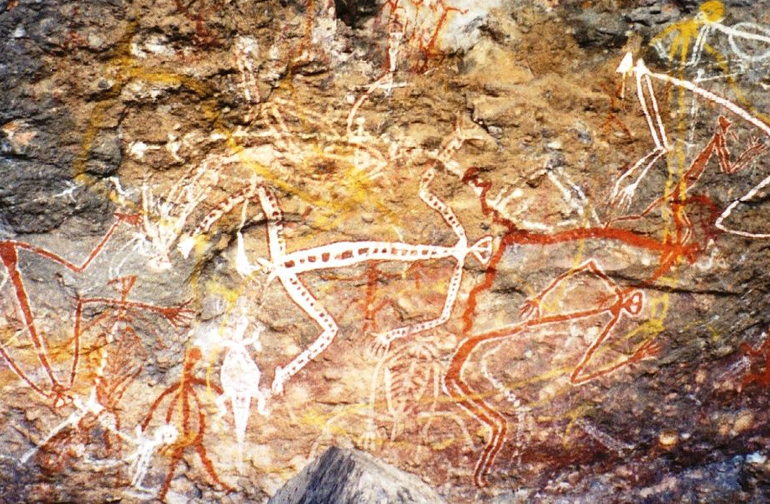Ed. Note: This is Chapter 17 of Brian’s book Credo. The book is available to download as a .pdf file here.
Many, though by no means all, indigenous peoples practiced sustainable land care and used concepts that contrast strongly with modern economics thinking. Much economic thinking is intrinsically ecologically destructive.
To describe the European merchant adventurers as “discovering” the rest of the world is a mis- description. What they thought they had discovered were “primitive” peoples – people who were virtually a part of the wildlife – to be driven out of desirable land areas or tamed and used as work animals. They attacked and took over and were aided, not only by their weaponry and ships but also by the diseases that they took with them. The invaders had some immunity to these diseases, but the populations of the “Americas” particularly, did not.
We cannot describe what subsequently happened around the world as the result of superior economics but rather as the outcome of successful military campaigns and organisation, together with luck for the invaders and the devastating effect of disease on the indigenous peoples. Millions of people of the first nations died in the Americas. In Africa millions were enslaved. In Australia campaigns of genocide were waged against aboriginal peoples. In India millions starved. Back in Europe the Irish starved too – while food was exported to Britain. History is not a story in which the good guys always win. The story of European colonialism was a story in which the mass murderers triumphed.
It therefore seems justified to describe the period that followed the writings of the scholastic economists as ones in which criminal gangs, who had earlier taken over as rulers of a number of European countries, who had stolen the rights of ordinary people in order to use the surrounding landscape by enclosing the common lands, now expanded their murderous businesses and practices into the rest of the world.
They had good PR techniques, one must acknowledge that. In order for gangs of psychopaths to justify their entitlement to murder and steal, a cloud of ideas, as well as much theatre and fancy clothing, complemented the intimidation. In medieval Europe, the gang leaders honoured themselves with titles like “King”, had crowns put on their heads, were robed in the finest clothes and exercised their power with a large amount of theatre. For example, “coronations” were held, preferably in buildings which had been standing for a few centuries, and involved being blessed on behalf of the sky god by priests who were also dressed up for the occasion. When you could do that over several generations your family has definitely made it…
Over time, pageantry and intimidation were not enough. Although helpful, you needed philosophers and thinkers to back you up too. The philosophers argued that the violence and theft perpetrated on people around the world was good for them. Furthermore it was incredibly useful to work to get colonised people to think in the same way as the colonisers. The central idea was that their subordination involved arrangements that were not only an improvement but that these arrangements were inevitable, they were desirable, they were progress.
That was where economics came in. Adam Smith helped with one of his formulations in which history was inevitably a progression towards “An Age of Commerce”. First came the age of hunters, then of pastoralists, then of agriculturists and then the Age of Commerce.
Nowadays, there is a slightly different formulation. There are “developing countries” and there are “developed countries”. The most recent words conceptually frame the fate of a number of countries very nicely. It makes clear that the people in “developing countries” are second class and that they need “help” to “develop”. They need multinational corporations to help them to do this – as well as NGOs.
However, the kind of development to which many societies and their supporting eco-systems have been subjected has often thrown the ecological system out of balance. Many pre-colonial ecological systems had a greater diversity – an interplay of different uses and different users. This was replaced by a smaller number of cultural types (plant and animal species) in a more specialised landscape with monocultures operating at a large scale. The resultant systems were sometimes pushed across ecological thresholds into a different state from which there is no simple turning back.
Economic principles that were ecologically destructive
What is certainly clear is that invading European colonists made plenty of ecological errors. The reasons for these errors are instructive. They show us clearly that the “principles of economics” as formulated by Smith, Malthus, Ricardo, Bentham and later economic theorists were contrary to the principles employed by many indigenous peoples and that they were, in fact, ecologically destructive.
Let us take again, an example from Australia from the book by Walker and Salt on Resilience thinking. The example concerns the Goulburn-Broken Catchment which is a sub system of the Murray Darling Basin. European settlers moved in from 1830, cleared the land for dairy pasture and horticulture and then, because of the vagaries of drought and flood, started to develop irrigation on a progressively larger scale. Dams were built and extended after each period of drought and the area became very prosperous – at first. However, an “ecological system threshold” was eventually reached because of the scale of irrigation. The water table rose to within 5 to 6 metres of the surface and there were rising problems of salinity. The problem has subsequently been addressed in an expensive fashion by pumping the groundwater but much of it is salty and this shifts the problem to somewhere else. (Walker & Salt, 2006, pp. 38-52) Over the last few decades the situation has been increasingly precarious.
As the ecological system has lost its resilience what can we say about the colonial “improvement”? Clearly that is was not sustainable – and what is not sustainable eventually comes to an end.
Having described what has happened Walker and Salt ask the question:
An interesting hypothetical: if the early settlers had been forewarned of the problems that would be faced some one hundred years later, and been in the possession of the information we now have, would they have made different decisions on how they developed the region? Probably no. A delay of one hundred years between an action and its consequences makes it difficult to take those consequences seriously. Humans have both high discount rates and an enormous capacity in believing the future will generate solutions to problems that don’t have to be faced in the foreseeable future. (Walker & Salt, 2006, p. 49)
But what kind of “humans” are Walker and Salt writing about?
As the two authors note, almost in passing, without further thought, the first occupants of this land were Aboriginal people who have been present for 8,000 to 10,000 years, possibly longer. The Aboriginal people had managed the grassy woodland during that time with periodic fires and during their time the water table was 20 to 50 metres below the surface. Were they not “humans” too? During their 8,000 to 10,000 years would the water table have been raised if they had had the technologies that were available to the white settlers?
Contrary to what Walker and Salt assert, as if writing about a universal human nature, the answer is “NO”. As a matter of fact, aboriginal people did use dams in water management but nothing on the scale used by the white settlers. Had they known that dams would be destructive of the ecological balance there is no question that they would not have used them.
When Walker and Salt assert that “humans” inevitably develop things and “can’t stop themselves” taking a short term view that sacrifices the interests of future generations for present ones, they are expressing the values and mind set of the European settlers and their “economic religion” but the religion of the aboriginal people was different. Like many other indigenous people, they had an ethic of land care that was integral to their spirituality and their way of life. This was based on a multi- generational care for the land – which is precisely what Walker and Salt imply is impossible given their economist-compatible assumptions about “human nature”.
Aboriginal land care practices were described in the previous chapter. What the Europeans at the time did not notice or realise… or perhaps found it in their interests to deny… was that the patchwork mosaic of species in the landscape, and the predominance of grassland, was a result of the management practices of the Aboriginal people who had lived there and cared for the land for thousands of years. The idea that Aboriginal peoples had created themselves a landscape that enabled them not to have to work very much did not match contemporary concepts of political economy. The European “civilisers” stole this landscape and degraded it by their unsustainable practices but were convinced that their kind of “development” was an improvement. Not understanding the practices and skills of Aboriginal people in the controlled use of burning, the settlers allowed grasslands to revert to forests. As the decades have passed it led to catastrophic fires that regularly occur in Australia. Had aboriginal landcare not been displaced this would not happen.
In theorising about efficiency and the management of resources with a western European mind-set, many “great thinkers” were unable to see efficiency when it was right in front of them, so steeped were they in a hubristic assurance of their own cultural superiority. Charles Darwin is an example. He described the aboriginal people as “harmless savages wandering about without knowing where they shall sleep at night and gaining their livelihood by hunting in the woods“. For all his powers of biological observation, he did not realise that the woods were part of a mosaic of land uses, created and maintained by fire management, to suit the needs of different species and intended to maintain biodiversity.
Had the settlers realised, or been prepared to acknowledge, the truth, it would have created serious problems for them – and for political economy. It would have undermined the principles that justified taking the land. Philosopher John Locke had argued that God gave the world to men in common but the justification of private property rights was that the land was to be used by “The industrious and rational” with “Labour to be the title to it”. Property was justified by the rational industry and improvement brought about by work. Had the settlers recognised that aboriginal people were industrious and rational, that they were managing the land, indeed that they had created the best land, then they would have had to have recognised that they themselves were interlopers and had no rights to the land. The settlers’ ignorance – or state of denial – prevented them acknowledging themselves for what they were – thieves – whose mission of “improvement” was destructive of a finely tuned eco-system.
The aborigines were industrious and rational. The needs of multiple species were taken into account. Their landcare was ecological system management, not just land management for a mono-culture. The thinking behind the burn patterns took into account the habitat needs of possums, wombats, birds, insects, reptiles and plants. Laying out the countryside to suit species, using burn patterns, led to highly complex landscape management, requiring great care over many generations and a knowledge not just of the needs of animals but the cycles of plants. (Gammage, 2011)
Fortunately for the aboriginal people, they did not think or behave with the market mind-set. When we look at how they did think and behave, without assuming European cultural superiority, their actions and thinking made a good deal of sense. Thus, contrary to the assumptions and assertions of the Reverend Thomas Malthus, Australian aboriginal people did not have a population that kept on growing in numbers until it reached the limits of food production. In 1788 they had what they thought of as abundance and could satisfy their needs with less work than all but the privileged Europeans because they practiced population control as a precautionary measure for their society. (Gammage, 2011, p. 151)
Contrary to the ideas of Adam Smith, the aboriginal people were not obsessed by the notion of scarcity and by technical improvement to overcome it. Like the societies described my Sahlins they regarded themselves as living in a state of abundance.
A further point is that aboriginal patterns of production never really matched Smith’s ideas about the “stages” of human economic evolution which were supposed to pass from hunting, to pastoralism, to agriculture, to commerce. The aborigines had refined living as “hunter-gatherers” and they included a mix of ways of hunting, gathering, cultivation and pastoralism all together, without fences or fixed residential settlements. The mix even included a limited place for trade but, above all, focused upon sustainability and what today we might term a “steady state economy”.
Aboriginal people did not think using economic categories
Not that the aboriginal people would have described or thought of what they did in the terminology of economics, ecological or otherwise. They did not worship efficiency and technology. Instead they had a relationship to ancestor creators and to a God who expected them to maintain the landscape, the creatures and plants in it, as it was and as they were. Whereas the Europeans were driven by a faith in change, in development, the aboriginal people saw themselves as duty bound to maintain things as they were.
So Salt and Walker are wrong in their assumptions of “humans”. There were humans that knew how to manage for the long term and did so effectively for thousands of years. The weakness on the Salt and Walker argument is to start their story where the white settlers arrived and to take the ideas of economics on faith – when it is just these ideas that are the problem.
In their land care too, aboriginal people made “land management decisions”, contrary to the assumptions of another economist, David Ricardo. Ricardo noticed that, in his own society, the best land was allocated for cultivation first and that the competitive demand for the best locations enabled the owners of the most productive land and/or the most desirable locations to charge a rent for it. The starting point for Ricardo’s theory of rent is the idea of the differential productivity of natural resources and the tapping of the best resources, or those easiest to access, first of all. This idea was later adapted by other economists and turned into the notion of declining marginal productivity. More generally, all economists assume that the natural resources that are easiest and cheapest to extract get used first.
Yet aboriginal people related to their landscape according to a different logic. Bill Gammage quotes the observations of a settler called Carnegie, about Helena Springs in the desert northwest of Lake Mackay. Helena Springs is the best water for hundreds of miles and Carnegie notes how it was much used by birds and animals. However, “Curiously enough, few native camps were to be seen, nor is this the first time that I have noticed that the best waters are least used… These desert people… have some provident habits, for first the small native wells are used, and only when these are exhausted are the more permanent waters resorted to.” (Gammage, 2011, p. 255)
In the Aboriginal System the aim of the game was not to maximise production it was to maintain the ecological balance. Since nature always fluctuates in some way living through maintaining a balance means culling or taking from that which is temporarily in surplus… while not taking from animals and plants that are in need of regeneration. Gammage quotes Latz, who explains:
In the desert you’ve got to have this system because you have really bad droughts and so on. You’ve got to have a sanctuary from where your animals can expand back after a drought. Not a single animal was allowed to be killed in this area. Not a single plant was allowed to be picked. These sanctuaries were scattered all over the landscape – wherever there was important Dreaming there was a sanctuary area. (Gammage, 2011, pp. 284-285)
What we call, using our westernised minds, two centuries further on from Adam Smith, “an economic system” is not really how other societies and cultures thought about their arrangements for living. In the language of economics, we think of “resource management arrangements” but there is a danger in only thinking in these terms because these words reduce and limit our understanding of the arrangements of other societies.
“Resource management arrangements” are what we have after the land has been fenced off by settlers and after there has been a process of colonial expropriation. It is what we have at the point that “economics” starts to be used to explain decisions about land. But “economics” cannot be used to adequately express what came before because there are no words in economics to express the full extent of what was taken away.
It is not merely “resources” that are taken away when land is expropriated, fenced off and subject to “improvement”. It is a way of life; spiritual responsibilities; individual and group identity; relationships to ancestors; relationships to contemporaries; relationships to successive descendants; to other species; relationship to the “Great Spirit” as inter-being which enfolds and unfolds all of these in and out of itself.
Why is this so?
Teaser photo credit: By Photo by and ©2002 Dustin M. Ramsey (Kralizec!) – My own photographic work., CC BY-SA 2.5





